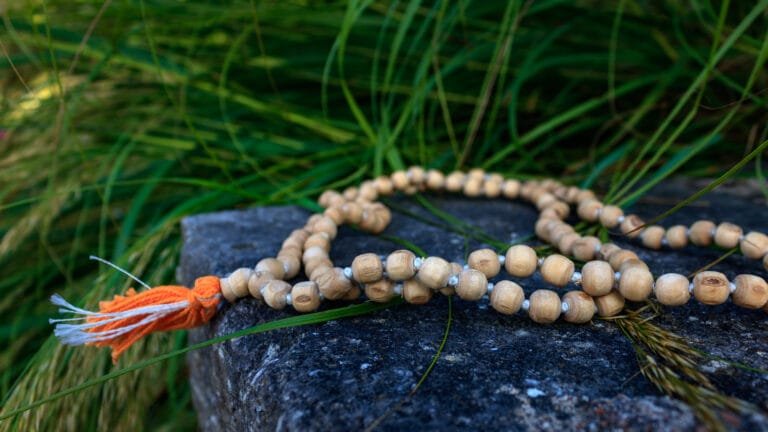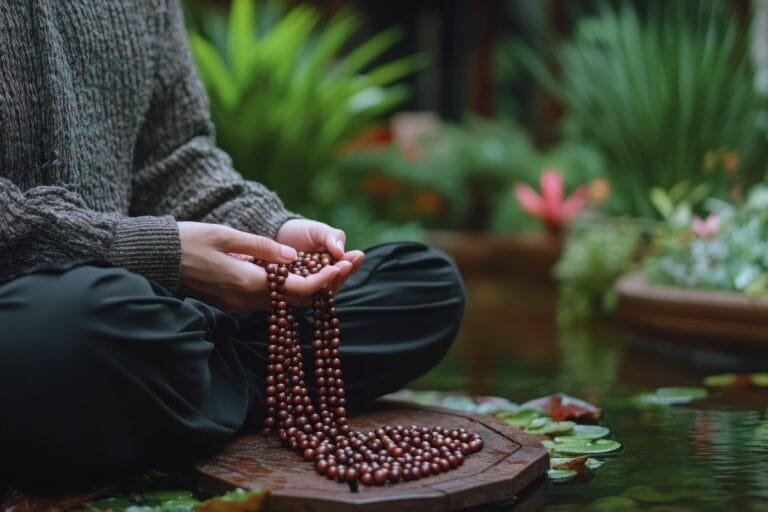108 Beads to Enlightenment: The Role of the Mala in Buddhist Meditation
The mala, a sacred string of 108 beads, is a crucial element in Buddhist meditation tools. It serves as both a meditation aid and a spiritual ornament. These beads help practitioners count mantras, improving focus and spiritual development. This practice is becoming more widespread, as people explore the profound meaning behind mala beads. This interest is fueled by their rich history in Buddhism and Hinduism.
Traditionally, the 108 beads in a mala create a unique bond with higher consciousness and one’s inner self. Each bead symbolizes a step towards enlightenment, holding transformative power as mantras or prayers are recited. Used in both spiritual retreats and daily routines, the mala’s true value lies in its ability to enrich meditation experiences and unlock its spiritual benefits. Let’s talk about the role of the mala in buddhist meditation.

The cultural significance of mala beads as a bridge between ancient traditions and modern spirituality is growing. This makes them invaluable in contemporary meditation practices. As more individuals engage with meditation, understanding the mala’s role in Buddhist meditation becomes crucial. For a deeper dive into the historical background of mala beads, click here: History and Significance of Mala Beads1.
Understanding Mala Beads
Mala beads, celebrated for their beauty and spiritual depth, are integral to meditation. Traditionally, they consist of 108 beads, acting as a meditation aid for focusing on mantras or prayers. The term “mala” in Sanskrit means “garland,” symbolizing their role in connecting us to our spiritual journey during meditation2.
Definition and Purpose of Mala Beads
A mala aids in counting mantras, aiding users in tracking their repetition during meditation. This practice improves concentration and enriches the meditation experience3. Many wear Buddhist prayer beads as jewelry, reminding them of their spiritual goals. This makes them useful for both spiritual and aesthetic purposes2.
Materials Used in Mala Construction
Mala beads are crafted from various materials, each with its own significance. These include:
- Natural Gemstones: Believed to possess specific healing properties.
- Wood: Commonly used in traditional malas, often made from Rudraksha seeds, which are associated with Hindu prayers.
- Seed Beads: Such as Bodhi seeds, which relate to Buddhist enlightenment.
- Crystals: Each type of crystal is thought to bring different energies to the wearer.
The choice of material can enhance the mala’s role as a meditation aid, aligning with the practitioner’s personal beliefs and practices4.
The Role of the Mala in Buddhist Meditation
The mala plays a vital role in meditation, enhancing experiences through its unique functions. Its primary function is to aid practitioners in using a mala in meditation by counting mantras. This ensures a focused and mindful meditation session.
Counting Mantras During Meditation
Traditionally, mala beads are used to count mantras or chanting, advancing through each of the 108 beads5. By moving one bead for each mantra, meditators maintain concentration without distraction. This practice tracks repetition and deepens engagement with the mantra’s meaning. It makes the mala a crucial tool for mala chanting practice, promoting focus and mindfulness.
Fostering Spiritual Connection and Focus
Another significant aspect of using a mala is fostering a deep spiritual connection. Counting mantras enhances mindfulness, promotes peace, and clarifies meditation. Many wear mala beads as a reminder of their meditation intentions and journey5. Thus, using a mala in meditation transcends counting; it becomes a core part of spiritual practice. The mala connects practitioners to their spiritual core, fostering a harmonious atmosphere for personal growth and reflection.
Historical Background of Mala Beads
The origins of mala beads date back over 3,000 years, rooted in ancient India’s spiritual traditions. Initially crafted for meditation, these sacred items reflect the dynamic evolution of spirituality. As we delve into the mala’s role, it becomes clear how these beads transitioned from spiritual tools to a global phenomenon, embraced by diverse cultures.
Origin and Evolution Through Time
Mala beads were first used in meditation to aid in mantra counting and deepen spiritual connection. Typically featuring 108 beads, this number holds deep meaning in Hinduism and Buddhism. In Hinduism, 108 represents sacred connections, such as the distance between humans and the divine, and significant Vedic texts6. Buddhism views the 108 beads as a representation of the delusions that hinder enlightenment, categorized by time7.
Mention in Ancient Texts and Traditions
The Mokugenji Sutra, among other ancient texts, highlights mala beads’ role in mantra recitation, underscoring their historical importance in meditation exploring the mala’s role. This tradition underscores the mala beads’ significance in spiritual practices and their integration into various cultures. Over time, mala beads have evolved, becoming fashionable accessories and tools for anxiety relief and mindfulness.
| Tradition | Significance of 108 |
|---|---|
| Hinduism | Units of distance to the divine, sacred sites, Vedic texts, life force points |
| Buddhism | Delusions blocking enlightenment, related to past, present, future |
The narrative of mala beads is a rich tapestry of spiritual exploration and cultural significance, still evolving today67.
Significance of 108 Beads
The number 108 holds profound significance in both Buddhist and Hindu traditions. In Buddhism, it represents the 108 human passions that obstruct the path to enlightenment. This number serves as a guide for introspection and spiritual development. In Hinduism, 108 symbolizes the distance from the physical body to the divine self, bridging the material and spiritual realms8.
Buddhist and Hindu Interpretations of 108
The significance of 108 transcends meditation. The Sanskrit alphabet, with 54 letters representing both masculine and feminine qualities, doubles to 108 when paired. Yogic traditions also acknowledge 108 sacred sites in India and 108 ancient Vedic texts, highlighting a rich cultural heritage8. These elements collectively offer a comprehensive perspective on existence and our spiritual journey.
Mathematical and Astronomical Significance
Mathematically, 108 is intriguing. It arises from the product of 1 to the power of 1, 2 to the power of 2, and 3 to the power of 3, showcasing natural elegance. Astronomically, 108 is a constant, as the distance from the sun to Earth is about 108 times the sun’s diameter. Similarly, the moon’s average distance to Earth is roughly 108 times the moon’s diameter9. These relationships underscore the cosmic importance of 108.
In astrology, 108 is significant as it is the product of 12 houses and 9 planets, linking the terrestrial and celestial realms. For yogis, performing 108 Sun Salutations during special occasions deepens spiritual connection and mindfulness. This reinforces the mala benefits derived from understanding this powerful number8.
Mala Benefits in Meditation Practice
Mala beads, known as Buddhist meditation tools, bring significant advantages to those who use them. These beads usually have 108 units, representing the spiritual core of the universe. Through meditation with mala beads, practitioners improve their focus and mindfulness, blocking out distractions.
Enhancing Concentration and Mindfulness
Counting the beads fosters a steady mental state, promoting deeper concentration. Regular meditation enhances one’s ability to focus. It’s advised to meditate daily, even for just five minutes, to fully benefit from mala benefits. Many wear their mala for 40 days to strengthen their meditation practice and intentions10.
This habit not only boosts mindfulness but also aligns with traditional meditation beliefs, emphasizing the importance of intention.
Spiritual Growth and Development
Mala use also aids in profound spiritual growth. Reciting mantras while using a mala deepens the connection to one’s intentions and inner wisdom. This practice leads to a better understanding of oneself and the universe. Gemstones like rose quartz for compassion and lapis for clarity are believed to enrich the spiritual experience further11.
Regular engagement in this meditative practice makes individuals feel more grounded and spiritually aligned.
Using a Mala in Meditation
Integrating a mala into your meditation practice can significantly enrich your experience. By utilizing the beads in a structured way, practitioners can enhance focus and achieve a deeper meditative state.
Step-by-Step Guide to Practicing with a Mala
Begin by holding the mala in your left hand, which is often connected to receiving blessings. Visualize your intention as you focus your thoughts on the mantra. Progress through each bead, repeating your chosen mantra, maintaining a calm, steady rhythm. This tactile experience of counting beads supports your meditation practice, enhancing feelings of well-being and purpose. Using a mala in meditation helps to reduce anxiety while encouraging mindfulness12 and13.
Common Mantras Used with Mala Beads
Practitioners often select from a variety of mantras tailored to their intentions, such as “Om Mani Padme Hum,” “Om Shanti Shanti Shanti,” or personal affirmations. Each repetition aids in grounding and focusing the mind, making mala chanting practice an integral part of their spiritual journey. Reciting a mantra for each bead around the loop completes a total of 108 repetitions, which allows for deeper reflection on the meaning of the mantra rather than merely counting12 and14.

| Mantra | Meaning |
|---|---|
| Om Mani Padme Hum | Compassion and the union of method and wisdom |
| Om Shanti Shanti Shanti | Peace, tranquility, and the encompassing of all |
| Lokha Samasta Sukino Bhavantu | May all beings be happy and free |
| Personal Mantras | Individual intentions or affirmations |
Mala Symbolism and Spiritual Significance
Mala beads are more than counting tools; they are deeply symbolic in spiritual practices. Their significance extends beyond mere counting, embodying profound spiritual meanings. These meanings enhance meditation and mindfulness, making them vital in various traditions.
The Lotus Flower and Higher Consciousness
The tassel of a mala represents the lotus flower, a symbol of purity and spiritual awakening. This connection links the user’s practice to a journey toward higher consciousness, a fundamental concept in Buddhist philosophy. The lotus embodies the potential for enlightenment, illustrating how one can rise from the depths of desire and defilement to attain spiritual clarity. Recognizing this connection can deepen the understanding of the spiritual significance of mala beads.
The Importance of the Guru Bead
The guru bead, an essential feature in mala design, symbolizes the teacher-student relationship in spiritual journeys. This bead serves as a poignant reminder of the respect and guidance a practitioner receives from their teacher. Often, the guru bead is not counted in repetitions, serving to honor this sacred relationship. Such practices highlight the spiritual significance of mala beads in fostering a sense of connection within the spiritual community.
This intricate interplay of elements within the mala structures supports practitioners in their quest for enlightenment. It enables a pathway to deeper mindfulness and spiritual growth151617.
Modern Adaptations of Mala Beads
In today’s wellness culture, mala beads have transcended their traditional meditation roles. They now blend fashion with spirituality, becoming fashionable accessories. Modern malas feature a variety of materials, from sandalwood and animal bones to gold, silver, and rare gemstones. This transformation has led to malas being found in mainstream fashion, alongside other jewelry, appealing to both spiritual and style-conscious individuals18.
Fashion and Spirituality Intersecting
Mala beads are more than meditation aids; they represent an aesthetic appealing to both men and women. Their role as symbols of mindfulness and devotion is now complemented by their presence in casual and high-fashion settings. This shift highlights the mala’s versatility, showing how modern designs can elevate daily wear while carrying deeper meanings of inner peace and focus18.
Non-Traditional Uses of Malas
Mala beads are used in various ways, reflecting their adaptability in modern life. They act as grounding tools in yoga, aids for anxiety, and decorative statements. Their increasing popularity has sparked interest in custom malas, where designers consider the wearer’s preferences and healing needs. This further broadens the mala’s relevance in today’s world19.
Source Links
- The History of Mala Beads – https://www.goldenlotusmala.com/pages/history-of-mala-beads?srsltid=AfmBOorjqKGDjLbI8Hp8BeDucPcu4krbWspqMjbJA6g9nLuN7j__cKa6
- Meditation With Mala Beads – https://www.goldenlotusmala.com/pages/how-to-meditate-with-mala-beads?srsltid=AfmBOopEpyJXxLDl5kjHmOVSsHeeBfnCndQ2uDtU775_csyKAw2E_qNz
- What are Buddhist Prayer Beads? 108 Buddha Mala Explained – https://monkmala.com/what-are-buddhist-prayer-beads/
- Meditation Mala Guide – https://buddhagroove.com/pages/meditation-mala-guide?srsltid=AfmBOoontr8-e6XmUvfK4yLVReSoGMlzxWhkhdYfyvtlDI-V1TbLevRE
- Meditation With Mala Beads – https://www.goldenlotusmala.com/pages/how-to-meditate-with-mala-beads?srsltid=AfmBOooqgjkE4AfmRBvf3XumP6snG7hFdTukrJM_LFt3KyHhwOJdGR8D
- The History of Mala Beads – https://www.goldenlotusmala.com/pages/history-of-mala-beads?srsltid=AfmBOorSwGMPT4i0mJ7B5hlnqV3iMMU_3ArPsoNl-7XEfIPDqwIn4lnS
- Worry Beads – https://tricycle.org/magazine/mala-beads-history/
- The History of Mala Beads – https://www.goldenlotusmala.com/pages/history-of-mala-beads?srsltid=AfmBOoqb3xuzbmYZX_cQrTMvMK6A9wkW7iz7vdzp14Q5el6xsSIJXgAJ
- What is a Mala and Why Does it Have 108 Beads? | Seven Corners – https://www.sevencorners.com/blog/travel-tips/what-is-a-mala-and-why-does-it-have-108-beads
- Meditation With Mala Beads – https://www.goldenlotusmala.com/pages/how-to-meditate-with-mala-beads?srsltid=AfmBOoo62JdtlGmdub_nRyTiX4rap51-8-tX9eXVv9LfghM2rElage-q
- Meditation Mala Guide – https://buddhagroove.com/pages/meditation-mala-guide?srsltid=AfmBOorwUJu30Y2cc-EjAbv7TbZpltoaV12bysZE3wIaIeFimzkHpmHd
- Meditation With Mala Beads – https://www.goldenlotusmala.com/pages/how-to-meditate-with-mala-beads?srsltid=AfmBOoqyioc9_WTlX8Ij1MOXeCblsp5Wf3U7mG1IXew6Fu37V03rL2xz
- How to Use Mala Beads For Meditation – https://www.healthline.com/health/how-to-use-mala-beads
- Using a Mala – Dharma Wheel – https://www.dharmawheel.net/viewtopic.php?t=1023
- The History of Mala Beads – https://www.goldenlotusmala.com/pages/history-of-mala-beads?srsltid=AfmBOoqAV-e6KThhhF5HYVISj-Mog-J41tFlULbtg_7ftJFo_OkAmmdG
- 108 Mala Beads: History, Symbolism and Power – https://mrlittlemonk.com/blogs/news/108-mala-beads-history-symbolism-power?srsltid=AfmBOookZp_N9C7HMd90SeDirpHW61JNdOob8sCp8FJBmiSXoRdPn8FI
- Top 6 Need to Know Benefits of Malas – https://www.dharmashop.com/blogs/news/top-6-benefits-of-malas-you-need-to-know?srsltid=AfmBOoqNWhBuVmKbT6tk76NwEcYyuqv_kBlkoANKz0N0g-aLx0R4IZEA
- Mala Beads Bring Enlightenment to Adornment | Art & Object – https://www.artandobject.com/articles/mala-beads-bring-enlightenment-adornment
- 108 Yoga Mala Beads Meaning & History of Yoga Prayer Beads – https://monkmala.com/what-are-yoga-mala-beads/








